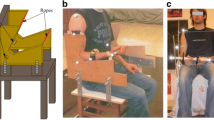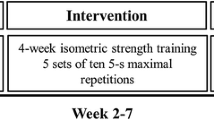Abstract
Purpose
Perception of action capabilities can be altered by changes in sensorimotor processes, as showed in previous works in populations dealing with regular and pathological sensorimotor deficits. Misestimating changes in performance ability could lead to risky behavior, injury, and/or reduced performance. However, the relationship between sensorimotor processes, the action-perception coupling, and the related anatomical structures is still a matter of debate. We investigated whether changes in the muscle–tendon system’s mechanical properties experimentally induced by eccentric contractions could alter the action-perception coupling (APC) in a reaching-to-grasp task, in which the participants estimated the maximal distance they predicted that they would able to reach a glass.
Methods
Based on their repartition, volunteers performed a conditioning session the first day: a series of isokinetic elbow extension in passive condition (control group, n = 11) or when performing elbow flexors eccentric contractions (eccentric group, n = 11). Performance estimates and actual performances in a reaching-to-grasp task were completed before, and immediately, 24 hours and 48 hours after the conditioning session. Alterations of musculo-articular mechanical properties were assessed through global joint stiffness (joint passive torque through load/unload cycles) and local stiffness (muscle elastography).
Results
The results showed that the APC related to reaching-to-grasp performance was not impacted by post-exercise changes in mechanical properties of the musculo-articular system.
Conclusion
These findings emphasize the central dimension of sensorimotor processing instead of peripheral structures to investigate the APC for an altered sensorimotor environment.






Similar content being viewed by others
Abbreviations
- Actual-D max :
-
Maximal actual reaching-to-grasp performance
- ANOVA:
-
Analysis of variance
- APC:
-
Action-perception coupling
- APratio :
-
Action-perception coupling ratio
- BB:
-
Biceps brachii
- CS:
-
Conditioning session
- CTL:
-
Control
- DOMs:
-
Delayed onset muscle soreness
- ECC:
-
Eccentric
- EMG:
-
Electromyography
- MAS:
-
Musculo-articular stiffness
- MVC:
-
Maximal voluntary contraction
- Perceived-D max :
-
Maximal perceived reaching-to-grasp performance
- p η 2 :
-
Partial-eta-squared values
- RMS:
-
Root mean square
- TB:
-
Triceps brachii
References
Ansems GE, Allen TJ, Proske U (2006) Position sense at the human forearm in the horizontal plane during loading and vibration of elbow muscles. J Physiol 576:445–455
Axelson H (2005) Muscle thixotropy: implications for human motor control. Acta, Universitatis Upsaliensis
Bercoff J, Tanter M, Fink M (2004) Supersonic shear imaging: a new technique for soft tissue elasticity mapping. IEEE Trans Ultrason Ferroelectr Freq Control 51:396–409
Bressel E, Larsen BT, McNair PJ, Cronin J (2004) Ankle joint proprioception and passive mechanical properties of the calf muscles after an Achilles tendon rupture: a comparison with matched controls. Clin Biomech 19:284–291
Bronson-Lowe CR, Loucks MT, Ofori E, Sosnoff JJ (2013) Aging effects on sensorimotor integration: A comparison of effector systems and feedback modalities. J Motor Behav 45:217–230
Buchanan TS, Roval GP, Zev Rymer W (1989) Strategies for muscle activation during isometric torque generation at the human elbow. J Neurophysiol 62:1201–1212
Chleboun GS, Howell JN, Conatser RR, Giesey JJ (1998) Relationship between muscle swelling and stiffness after eccentric exercise. Med Sci Sport Exer 30:529–535
Clarkson PM, Tremblay I (1988) Exercise-induced muscle damage, repair, and adaptation in humans. J Appl Physiol 65:1–6
Cohen J (1988) Statistical power analysis for the behavioral sciences. Lawrence Erlbaum Associates, Hillsdale
Comalli D, Franchak J, Char A, Adolph K (2013) Ledge and wedge: younger and older adults’ perception of action possibilities. Exp Brain Res 228:183–192
Daviaux Y, Mignardot J-B, Cornu C, Deschamps T (2014) Effects of total sleep deprivation on the perception of action capabilities. Exp Brain Res 232:2243–2253
Daviaux Y, Cremoux S, Tallet J, Amarantini D, Cornu C, Deschamps T (2016a) An enhanced experimental procedure to rationalize on the impairment of perception of action capabilities. Psychol Res 80:224–234
Daviaux Y, Cremoux S, Tallet J, Amarantini D, Cornu C, Deschamps T (2016b) I can’t reach it! Focus on theta sensorimotor rhythm toward a better understanding of impaired action-perception coupling. Neuroscience 339:32–46
Denes G (1999) Disorders of body awareness and body knowledge. In: Denes G, Pizzamiglio L (eds) Handbook of clinical and experimental neuropsychology. Psychology, Hove, pp 497–506
Deschamps T, Magnard J, Jubeau M, Hug F, Tucker K (2016) Altered force-generating capacity is well-perceived regardless of the pain presence. J Exp Psychol Hum 42:1363–1371
Fisher MH (2000) Estimating reachability: Whole body engagement or postural stability? Hum Movement Sci 19:297–318
Fortier S, Basset FA (2012) The effects of exercise on limb proprioceptive signals. J Electromyogr Kines 22:795–802
Franca M, Turella L, Canto R, Brunelli N, Allione L, Andreasi NG, Fadiga L (2012) Corticospinal facilitation during observation of graspable objects: a transcranial magnetic stimulation study. PLOS One 7:e49025.
Franchak JM, van der Zalm DJ, Adolph KE (2010) Learning by doing: action performance facilitates affordance perception. Vision Res 50:2758–2765
Graydon MM, Linkenauger SA, Teachman BA, Proffitt DR (2012) Scared stiff: The influence of anxiety on the perception of action capabilities. Cognition. Emotion 26:1301–1315
Gregory JE, Morgan DL, Proske U (1988) Aftereffects in the responses of cat muscle spindles and errors of limb position sense in man. J Neurophysiol 59:1220–1230
Gregory JE, Morgan DL, Proske U (2004) Responses of muscle spindles following a series of eccentric contractions. Exp Brain Res 157:234–240
Grigg P (1994) Peripheral neural mechanisms in proprioception. J Sport Rehabil 3:2–17
Grunwald M, Ettrich C, Assmann B, Dähne A, Krause W, Busse F, Gertz HJ (2001) Deficits in haptic perception and right parietal theta power changes in patients with anorexia nervosa before and after weight gain. Int J Eat Disord 29:417–428
Guardia D, Lafargue G, Thomas P, Dodin V, Cottencin O, Luyat M (2010) Anticipation of body-scaled action is modified in anorexia nervosa. Neuropsychologia 48:3961–3966
Guardia D, Conversy L, Jardri R, Lafargue G, Thomas P, Dodin V, Cottencin O, Luyat M (2012) Imagining one’s own and someone else’s body actions: dissociation in anorexia nervosa. PLOS One 7:e43241
Hackney AL, Cinelli ME (2013) Young and older adults use body-scaled information during a non-confined aperture crossing task. Exp Brain Res 225:419–429
Herbert RD, Clarke J, Kwah LK, Diong J, Martin J, Clarke EC, Bilston LE, Gandevia SC (2011) In vivo passive mechanical behaviour of muscle fascicles and tendons in human gastrocnemius muscle-tendon units. J Physiol 589:5257–5267
Hermens HJ, Freriks B, Disselhorst-Klug C, Rau G (2000) Development of recommendations for SEMG sensors and sensor placement procedures. J Electromyogr Kines 10:361–374
Hirose N, Nishio A (2001) The process of adaptation to perceiving new action capabilities. Ecol Psychol 13:49–69
Howatson G, Van Someren K, Hortobagyi T (2007) Repeated bout effect aftermaximal eccentric exercise. Int J Sport Med 28:557–563
Howell JN, Chleboun G, Conatser R (1993) Muscle stiffness strength loss swelling and soreness following exercise-induced injury in humans. J Physiol 464:183–196
Jaberzadeh S, Nazeran H, Scutter S, Warden-Flood A (2001) Mechanically evoked torque and EMG responses during passive elbow extension component of upper limb tension test. In: 23rd Annual International Conference of the IEEE Engineering in Medicine and Biology Society, Istambul, Turkey
Keizer A, Aldegonda M, Smeets M, Dijkerman HC, Van den Hout M, Klugkist I, van Elburg A, Postma A (2011) Tactile body image disturbance in anorexia nervosa. Psychiat Res 190:115–120
Kingdom F, Prins N (2009) Psychophysics: a practical introduction. Elsevier, San Diego
Lacourpaille L, Nordez A, Hug F, Couturier A, Dibie C, Guilhem G (2014) Time-course effect of exercise-induced muscle damage on localized muscle mechanical properties assessed using elastography. Acta Physiol 211:135–146
Latash ML (2008) Neurophysiological basis of movement. Human Kinetics, Urbana
Lau WY, Blazevich AJ, Newton MJ, Wu SS, Nosaka K (2015) Assessment of muscle pain induced by elbow-flexor eccentric exercise. J Athl Train 50:1140–1148
Lee AC, Harris JP, Atkinson EA, Fowler MS (2001) Disruption of estimation of body-scaled aperture width in Hemiparkinson’s disease. Neuropsychologia 39:1097–1104
Luyat M, Domino D, Noël M (2008) [Can overestimating one’s own capacities of action lead to fall? A study on the perception of affordance in the elderly]. Geriatr Psychol Neurol 6:287–297
Maisetti O, Hug F, Bouillard K, Nordez A (2012) Characterization of passive elastic properties of the human medial gastrocnemius muscle belly using supersonic shear imaging. J Biomech 45:978–984
Mark LS (1987) Eye height-scaled information about affordances: a study of sitting and stair climbing. J Exp Psychol Human 13:361–370
Nordez A, McNair P, Casari P, Cornu C (2006) Acute changes in hamstrings musculo-articular dissipative properties induced by cyclic and static stretching. Int J Sport Med 29:414–418
Nosaka K, Sakamoto K, Newton M, Sacco P (2001) The repeated bout effect of reduced-load eccentric exercise on elbow flexor muscle damage. Eur J Appl Physiol 85:34–40
Ogden JA (1985) Autotopagnosia. Occurrence in a patient without nominal aphasia and with an intact ability to point to parts of animals and objects. Brain 108:1009–1022
Oldfield RC (1971) The assessment and analysis of handedness: the Edinburgh inventory. Neuropsychologia 9:97–113
Oliveira JM, Volchan E, Vargas CD, Gleiser S, David IA (2012) Box for interaction with objects (BIO): a new device to synchronize the presentation of objects with electrophysiological recordings. Behav Res Methods 44(4):1115–1120
Prinz W, Hommel B (2002) Common mechanisms in perception and action: Introductory remarks. In: Prinz W, Homme B (eds) Attention and performance XIX: common mechanisms in perception and action. Oxford University Press, New-York, pp 1–3
Proske U, Gandevia S (2012) The proprioceptive senses: theur roles in signaling body shape body position and movement and muscle force. Physiol Rev 92:1651–1697
Proske U, Morgan DL (2001) Muscle damage from eccentric exercise: mechanism mechanical signs adaptation and clinical applications. J Physiol 537:333–345
Riemann BL, DeMont RG, Ryu K, Lephart SM (2001) The effects of sex joint angle and the gastrocnemius muscle on passive ankle joint complex stiffness. J Athl Train 36:369–375
Rochat P, Wraga M (1997) An account of the systematic error in judging what is reachable. J Exp Psychol Human 23:199–212
Sakurai R, Fujiwara Y, Ishihara M, Higuchi T, Uchida H, Imanaka K (2013) Age-related self-overestimation of step-over ability in healthy older adults and its relationship to fall risk. BMC Geriatr 13:44
Smith JG, Harris JP, Khan S, Atkinson EA, Fowler MS, Ewins D, D’Souza S, Gregory RP, Kean RJ (2011) Motor asymmetry and estimation of body-scaled aperture width in Parkinson’s disease. Neuropsychologia 49:3002–3010
Thill S, Caligiore D, Borghi AM, Ziemke T, Baldassarre G (2013) Theories and computational models of affordance and mirror systems: an Integrative Review. Neurosci Biobehav R 37:421–491
Walsh LD, Hesse CW, Morgan DL, Proske U (2004) Human forearm position sense after fatigue of elbow flexor muscles. J Physiol 558:705–715
Walsh LD, Allen T, Gandevia SC, Proske U (2006) Effect of eccentric exercise on position sense at the human forearm in different postures. J Appl Physiol 100:1109–1116
Whitehead NP, Weerakkody NS, Gregory JE, Morgan DL, Prosk U (2001) Changes in passive tension of muscle in humans and animals after eccentric exercise. J Physiol 533:593–604
Windhorst U (2007) Muscle proprioceptive feedback and spinal networks. Brain Res Bull 73:155–202
Yu Y, Stoffregen TA (2012) Postural and locomotor contributions to affordance perception. J Mot Behav 44:305–311
Yu Y, Bardy B, Stoffregen TA (2011) Influences of head and torso movement before and during affordance perception. J Mot Behav 43:45–54
Acknowledgements
The authors thank Dr René Faynot for performing the medical examination. The research was supported by grants from the Region of Pays de la Loire, France, for the Project “RP3AP”. The sponsors had no role in the design and conduct of the study, in the collection, management, analysis, and interpretation of the data, or in the preparation, review, or approval of the manuscript.
Author information
Authors and Affiliations
Corresponding author
Ethics declarations
Conflict of interest
The authors report no conflicts of interest.
Additional information
Communicated by Olivier Seynnes.
Rights and permissions
About this article
Cite this article
Daviaux, Y., Deschamps, T. & Cornu, C. Changes in elbow joint’s musculo-articular mechanical properties do not alter reaching-related action-perception coupling. Eur J Appl Physiol 117, 819–832 (2017). https://doi.org/10.1007/s00421-017-3570-8
Received:
Accepted:
Published:
Issue Date:
DOI: https://doi.org/10.1007/s00421-017-3570-8




